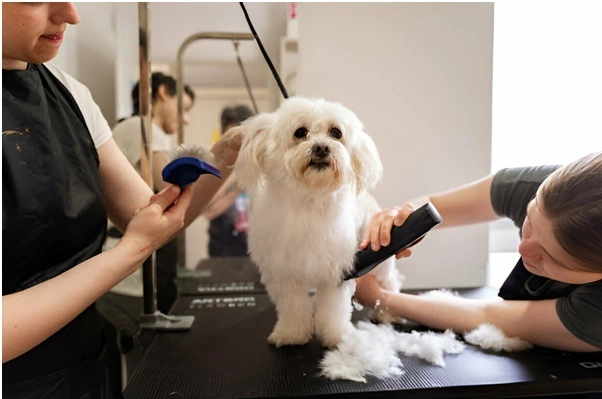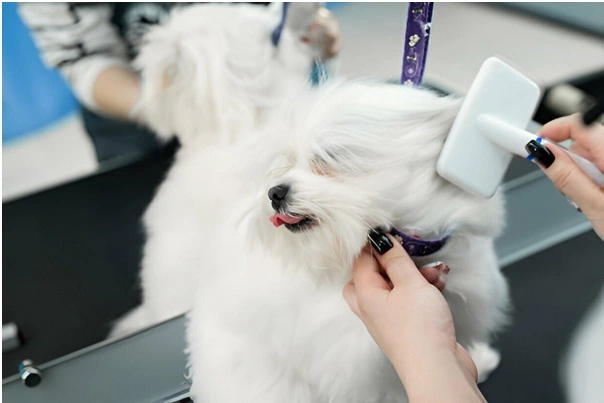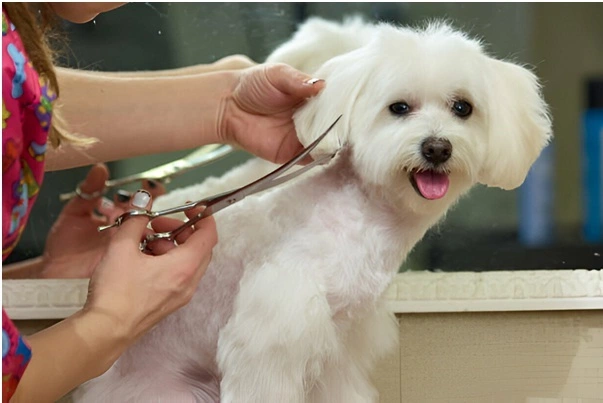
It is advisable to keep track of the types of tools that are being utilized for a dog with a heavy coat. While dogs do satisfy the shedding requirement, excessive fur can still lead to problems. Different techniques can be used to assist with grooming. Not only does grooming reduce the amount of fur shed, but it also promotes a healthy and shiny coat. Shedding is actually reduced by regularly brushing, bathing the dog, and feeding a nutritious diet. These techniques will help to master essential grooming practices while fostering a clean living space for the pet owner and a happy and well-groomed dog.
The Importance of Grooming for Heavy-Coated Dogs
Grooming is an essential procedure to ensure the health and comfort of heavy-coated breed dogs. Regular grooming ensures that loose fur along with most fur is shed and painful matting is avoided which can aggravate the skin. Brushing is also necessary for maintaining skin health, as it helps to circulate the natural oils in the coat. In addition to this, proper grooming enables air circulation thus reducing the chances of infection on the skin by dirt and moisture that is somehow trapped deep in the coat.
Proper grooming also allows for inspection of skin problems, fleas, and ticks hence, can assist in detecting other health issues that may have developed. Incorporating this on a regular basis, will guarantee that the dog’s fur coat is not ridiculously dense thus enhancing the dog’s overall comfort.
How to Keep Dog Shedding Under Control
The shedding of dogs can be controlled by trimming and basic grooming techniques. First, the dog should be brushed periodically to help the loosened furs come out, and matting should be avoided. Make use of de-shedding tools or brushes that are specifically made for the type of coat your dog possesses.
Give your dog a bath with a gentle shampoo while using a dog de-shedder, which helps to remove the excess fur and also the coat of the dog from getting damaged. Do thoroughly while drying them since moist furs on the dog can bring along furry skin issues as well as fur loss. Furthermore, trimming of long-haired dogs helps minimize the amount of shedding that occurs due to the hair becoming too long to manage.
An appropriate type of diet is helpful in keeping the skin and fur healthy and in shape. Make sure to add omega 3 fatty acids in their diets as they help in improving the fur quality and also reduce shedding. Always make sure that your dog has water available as it helps prevent skin from going dry and increasing fur shedding.
Maintain the hygiene of your dog by doing some vacuuming and rolling some lint in order to do some stray hair pick up. Fur loss will accumulate on the furniture so cover them with some linens that can be washed are used for easy clean up.
And lastly, check on the dog once in a while for the hair he loses. If it seems like there is a lot of shedding out of indeed it not being normal or is unproportionate, take note and reach out to the animal doctor to rule out the matters of health. These techniques can assist in fostering shedding control and maintenance along with a hair-free living environment.
Understanding Dog Coat Types and Their Grooming Needs

- Smooth-coated dogs: Dogs that are smooth-coated need to be brushed at least once a week to get rid of loose fur so that their coat stays shiny, smooth, and healthy. Moderately shedding breeds do not need to be groomed very often, however, brushing reduces the amount of shedding fur around the home.
- Double-coated breeds: Breeds that have two coats shed a lot during certain months of the year and require constant grooming in order to keep their coats clean. Proper brushing should be done regularly in order to prevent the matting of fur in breeds like Huskies or Golden Retrievers.
- Curly-coated dogs: Dogs with curly hair like poodles or bichon frise require neat and clean curls at all times in order to prevent their furry coats from becoming tangled. Regular trimming along with delicate brushing helps to maintain their unique fluffy soft corkscrew curls.
- Long-haired breeds: Breeds with long hair need to be groomed all the time in order to prevent their hair from tangling. Regular brushing keeps their hair smooth while removing mats ensures that their skin is not irritated.
- Wire-haired dogs: Dogs with rough coats like Terriers require proper grooming in the form of occasional hand stripping to remove excess hair in order to maintain healthy, rough skin underneath. Proper brushing helps to keep the skin of the breed free from irritation while maintaining a clean coat.
Keep Seasonal Shedding Under Control with These Expert-Approved Tips

Dogs generally shed during this time to make space for new fur. However, there are some techniques that might mitigate the shedding and aid with cleaning the shedding. Employ these practices suggested by the experts to improve your dog’s shedding and fur growth while improving the overall hygiene of your home.
1. Brush Your Dog Regularly
When dogs shed, it is critical that they brush their furs regularly and adequately. A de-shedding tool or slicker brush is a good choice for brushing, as well as an undercoat rake for shedding. In addition, specific skills gained through dog grooming undercoat training aid in grooming the fur. It is important to brush for at least three to four times a week during shedding season. By doing so, you can prepare for brushing as well as have the model achieve better skin oil circulation which ensures fur is kept everywhere without spreading.
2. Bathe Your Dog with Deshedding Shampoo
Your dog can lose a lot of fur, but it can be reduced with the use of a de-shedding shampoo. By using these pet-friendly shampoos, you can get rid of extra fur while nourishing the skin and coat. Mixing them with water makes their application gentler, and washing them off thoroughly can prevent itchy irritation long after the bath. Towel drying your pooch or using a pet-friendly dryer will prevent skin issues by getting rid of moisture.
3. Maintain a Balanced Diet
Shedding can be controlled with the right diet. By giving your dog proper food rich in omega 3 and omega 6 ensures a healthier skin and coat. Foods like fish and flaxseed can help reduce excessive shedding. If you’re interested in more effective coat health, your veterinarian can recommend proper dietary supplements.
4. Hydrate Your Dog
Make sure your dog is hydrated enough since dehydration can lead to flaky skin and shedding. Providing clean water at all times and regularly encouraging your dog to drink will keep the skin moisturized and healthy, reducing shedding. Proper hydration not only improves the skin but also greatly reduces the risk of losing fur.
5. Use a Grooming Schedule
In order to minimize the effects that shedding has on your property, it is important to have a set routine for your pooch’s grooming schedule. If you notice your dog is shedding more, try bathing and brushing them more to prevent carpets and furniture from becoming too hair-coated. Following a set routine allows for grooming to become a natural method of caring for your pet.
6. Keep Your Home Clean
Even when pets are groomed properly, some shedding is bound to occur within the house. A recommended tip is to use a specialized vacuum cleaner to clear carpets and pet furniture. Use lint rollers on clothes and smaller surfaces to clear fallouts easily. You can also have washable covers on the furniture to protect the sofas and chairs from falling hair for easy removal.
7. Consult Your Veterinarian
If a pooch is losing fur unreasonably or in patches, it is best to take them to the veterinarian for an examination. Some shedding can be signs of severe allergies, infections, or nutrient deficiency going missed. Getting treated will help the pet move to healthy stages again and not worry the owner.
8. Provide Comfort During Shedding Seasons
Your dog may feel uncomfortable during the process of shedding, particularly if there are mats and tangles present in their fur. Having a comfortable clean bed and a lookout for skin irritations can assist in averting this issue. Additionally, soothe your dog while they are being groomed by speaking in a soft tone while offering them treats. This creates a conducive atmosphere worth looking forward to for your furry friend.
9. Avoid Overbathing
Bathing your dog on a weekly basis is advisable but overdoing it will strip their coat of essential oils resulting in severe dryness. This leads to further shedding resulting in a vicious cycle that’s difficult to manage. During shedding season, dogs should be bathed every two to three weeks or whenever it is exceptionally needed otherwise bathing can lead to the aforementioned consequences. This way, dogs can maintain a wonderful coat free from excessive oils.
Conclusion
In the details provided above, I believe it is safe to conclude certain measures that powerful and active fur shedding in dogs must be managed consistently with the right tools, effective grooming, and shedding strategies. As balanced diet, hydration, routine brushing, and de-shedding shampoo usage can aid in covering undesirable and excessive fur. Monitoring the coat regularly helps to control excessive shedding and the possibility of matting with skin irritation. Following these measures will help have a happier dog and create a cleaner home.